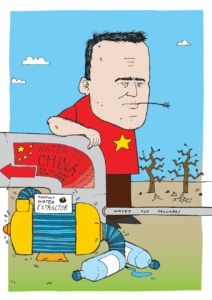Economic Development Minister Steven Joyce was in Hawke’s Bay last week, breathlessly announcing that a new co-location of offices for our region’s economic development bureaucrats would unlease the area’s business potential. “All lagging Hawke’s Bay has needed to unlock its economic potential was a single water cooler or coffee machine around which the region’s umpteen economic development officers could congregate at tea break to agree on strategies,” he announced at the ribbon-cutting. Adding as an afterthought: “Oh, that and a $600 million dam investment and a bit of oil & gas development.”
At least that’s how HB Today covered the story.
But BayBuzz got the true scoop in this private interview with Minister Joyce.
“I’m really here to sell plastic … plastic bottles to be precise,” he confided.
“When the bottling of aquifer water really takes off,” he gushed, “there will be billions to be made in manufacturing plastic water bottles.
“Yes, you can sell the water. And I urge everyone living on top of the Heretaunga aquifer to get a water consent tomorrow. If you don’t grab one, foreign investors will. The Regional Council’s giving them out like there’s no tomorrow and — can you believe this — the water is free. Gushing out water consents is like printing money. Pretty soon with all its drilling derricks the Heretaunga Plains should look like Oklahoma oil country. If you can’t afford a well, then sell your tap water.”
“All you need is bottles.”
Now Joyce was getting really pumped up.
“And that’s where the big profit is. Forget the water; the real money and mark-up is in the bottles … you have to think about the entire value chain. If I lived in Hawke’s Bay I’d invest in manufacturing PLA bottles … PLA is polymerised lactic acid. And if manufacturing isn’t your forte, just grow the corn the PLA comes from. Hell, anyone can grow corn in their back yard! The corn-growers won’t make as much money as the bottle-makers, but hey, that’s the sad story of farming.”
“But what happens if we run out of aquifer water?” asked BayBuzz. “Won’t that dry up the market for polymerised lactic acid?”
“Put a cork in it!” retorted Joyce. “Your own Regional Council says that the Heretaunga aquifer has unlimited quantities of water, all of it simply washing out to sea. In two or three years the Regional Council will release research proving that.”
Asked if it wouldn’t be prudent to wait for the research before investing heavily in cornfields and plastic extruding machines, Joyce replied: “I’m confident your council’s science will suit the occasion. Anyway, once you make the investment in bottling plants, there’s no turning back … just like that dam of yours. The key is to first get the bottles made and the concrete poured. And if there’s an unexpected hiccup with the science, your councils can always institute water bans for lawn watering, showering and tooth brushing. In fact I heard a radio commercial urging water conservation and saying “our water is precious” on my way into town from the airport. That’s a nice touch … start building the guilt, just in case.”
So there you’ve heard it. Straight from the Uber Minister.
Think about the entire value chain coming to Hawke’s Bay …
More council staff to process consents. More corn crops. More fertiliser for the corn. More lawyers and accountants for farmers. More polymerised lactic acid processing facilities. More plastic bottle manufacturing. More work for creative agencies designing bottle labels. More paper for the labels, and logging to produce the paper. More trucks to carry the logs and then the containers of bottles to the Port. The value chain extends further and further. More stevedores for the Port. More beer for the stevedores, who ‘replenish’ the aquifer … a virtuous cycle. The velocity of money is mouth-watering.
All because of limitless free water and plastic bottles from corn.
Who says God isn’t smiling on Hawke’s Bay?
Tom Belford
P.S. I ran Joyce’s strategy past the region’s expert in bottling, Tim Noble-Ustinoff. He operates the plant that bottles virtually every drop of Hawke’s Bay wine. Tim agrees that the real value of just about every product is in the packaging. But he emphasizes that high-end coloured water (i.e., wine as opposed to cranberry juice) is packaged in glass bottles, not plastic, hence the premium price that wine commands over pure water (and cranberry juice). “I wouldn’t say winemakers don’t contribute anything,” says Tim, “but everyone knows that above all else the high-end connoisseur demands a glass bottle with a flash label. If you want to make big money off water, it’s gotta be in a glass bottle. Has Minister Joyce never heard of Perrier or Pellegrino?”

